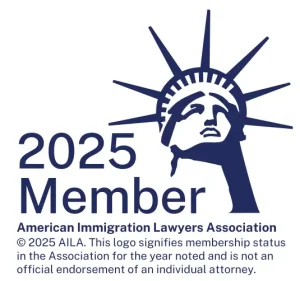Your complete guide to E-2 employee visas, spouse work authorization, and family benefits for Canadians
If you’re a Canadian working for an E-2 treaty investor business—or planning to—you need to understand your immigration options and family benefits. While much of the attention goes to E-2 business owners and investors, E-2 employees have access to excellent immigration benefits, especially for Western Canadians who can use the Calgary consulate.
E-2 Employee Visas: Working for Treaty Investor Businesses
What Is an E-2 Employee?
E-2 employees work for businesses owned by treaty country nationals (in this case, Canadian citizens) that have qualified for E-2 treaty investor status. You don’t need to be an investor yourself—you’re an employee of a registered E-2 enterprise.
Who Qualifies as an E-2 Employee?
Not every employee of an E-2 business qualifies for E-2 employee status. You must be either:
- Executive or supervisory personnel with ultimate control and responsibility for the enterprise’s overall operation or a major component
- Employees with essential skills that are highly specialized and essential to the efficient operation of the enterprise
The key is that your role must be more than routine labor or services. USCIS and consular officers look for positions that require specialized knowledge, supervisory authority, or essential technical skills that aren’t readily available in the U.S. labor market.
The Calgary Consulate Advantage for Western Canadians
Here’s excellent news for Canadians in Alberta, British Columbia, and Saskatchewan: You can apply at the Calgary consulate for E-2 employee visas.
Once a Canadian E-2 business is registered with the Toronto consulate (required for initial company registration), employees and their family members can schedule visa appointments at any of the Canadian consulates: Calgary, Montreal, Ottawa, Vancouver, or Toronto.
For Western Canadians, this means:
- No travel to Toronto required for employee visa applications
- Calgary is 550 miles from our Montana office, making us geographically convenient for consultations
- Faster processing with more convenient appointment availability
- Easier document review with an attorney who understands Calgary consulate procedures
Family Benefits: Spouses and Children
E-2 Spouse Work Authorization: A Major Advantage
One of the most valuable benefits of E-2 employee status is that your spouse can work anywhere in the United States.
How E-2 Spouse Work Authorization Works
Your spouse receives derivative E-2 status and is automatically work authorized based on their status. As of January 30, 2022, E-2 spouses receive an I-94 (Arrival/Departure Record) with the designation “E-2S” which proves work authorization. With this status, your spouse can:
- Work for any employer in the United States
- No sponsorship required from the employer
- Immediate work authorization upon receiving E-2S status
- No Form I-765 required – the I-94 itself proves work authorization
- Valid as long as your E-2 status remains valid
Optional EAD Card: While not required, E-2 spouses may choose to apply for an Employment Authorization Document (EAD card, Form I-766) using Form I-765. This provides a physical card that some find easier to present to employers, but it’s completely optional—the I-94 with E-2S designation is sufficient proof of work authorization.
This is particularly valuable for Canadian families where both spouses have professional careers. Unlike many other visa categories that restrict dependent employment, E-2 provides full work authorization for spouses.
Strategic Use: Path to Permanent Residency
Smart Canadian families use E-2 spouse work authorization strategically. If one spouse has highly marketable skills (IT, healthcare, engineering, etc.), consider this approach:
- One spouse works as E-2 employee for the treaty investor business
- Other spouse gets EAD through derivative E-2 status
- Spouse with marketable skills uses EAD to work for any U.S. employer
- After proving value, that spouse’s employer sponsors them for employment-based green card
- Entire family benefits from permanent residency
This strategy works because U.S. employers won’t invest in expensive green card sponsorship for unknown workers, but they will for proven employees. The E-2 derivative status gives your spouse the chance to prove themselves first.
E-2 Children: Education Rights
Unmarried children under 21 receive derivative E-2 status and can:
- Attend U.S. public schools (elementary and secondary)
- Attend college or university in the United States
- Maintain legal status while in school
However, children cannot work based solely on E-2 dependent status. They would need to:
- Transition to F-1 student status (which allows limited on-campus work and Optional Practical Training)
- Obtain their own work visa (H-1B, E-2 employee status, etc.)
- Qualify for other work authorization programs
Application Process for E-2 Employees
Initial Company Registration (Toronto Required)
Before any employees can apply, the E-2 business itself must be registered. For Canadian companies, this initial registration must go through the Toronto consulate. This is not optional—Toronto handles the company registration for all new Canadian E-2 treaty investor applications.
The Toronto consulate reviews:
- The substantial investment made in the U.S. enterprise
- The business’s capacity to generate more than marginal income
- Evidence that the business is real, active, and operating
- The investor’s commitment to develop and direct the enterprise
Once Toronto approves and registers the company, employees can apply at other consulates.
Employee Applications (Calgary and Other Consulates)
After the company is registered in Toronto, E-2 employee applications can be filed at:
- Calgary
- Montreal
- Ottawa
- Vancouver
- Toronto
For employee applications, you’ll need:
- Proof of Canadian citizenship (passport)
- Evidence of E-2 company registration (provided by your employer)
- Job offer letter explaining your executive, supervisory, or essential skills role
- Resume/CV demonstrating qualifications for the specialized position
- Company organisational chart showing your position and reporting structure
- Educational credentials or professional certifications supporting your qualifications
- Form DS-160 (online nonimmigrant visa application)
Processing Times and Validity
E-2 visas are typically issued for up to 5 years for Canadians, though initial grants may be shorter. The visa can be renewed indefinitely as long as:
- The E-2 business continues operating
- Your employment continues
- You maintain your qualifying role
Common Questions About E-2 Employee Status
Can I Switch Employers?
E-2 employee status is specific to the sponsoring E-2 business. If you want to change employers, you’ll need:
- A new E-2 employer to sponsor you, or
- A different visa status (H-1B, new E-2 if you become an investor, etc.)
Do I Need to Live in the United States Full-Time?
Unlike green card holders, E-2 employees have no specific minimum presence requirement in the United States. However, your visa is for the purpose of working for the E-2 enterprise, so extended absences that suggest you’re not actually fulfilling that role could raise questions at the border or during renewals.
Can E-2 Employees Lead to Green Cards?
E-2 is a nonimmigrant visa, meaning it doesn’t directly lead to permanent residency. However, smart Canadian families use E-2 status as a bridge:
- Spouse work authorization strategy described above (spouse gets sponsored for green card)
- EB-5 investment if the family accumulates sufficient capital
- Marriage to U.S. citizen (if applicable)
- Employment-based sponsorship if you transition to a role that qualifies for permanent labor certification
What Happens When Children Turn 21?
Children “age out” of E-2 dependent status when they turn 21 or marry. At that point, they need to transition to:
- F-1 student status if in college
- Their own work visa (H-1B, E-2 employee if they qualify, etc.)
- Other status based on their circumstances
Planning for this transition before it happens is critical to avoid gaps in legal status.
Why E-2 Employee Positions Are Valuable
E-2 employee status offers significant advantages compared to many other work visa categories:
Compared to H-1B:
- No annual lottery or cap
- Longer initial validity periods
- Spouse can work immediately (H-1B spouses have limited work authorization)
- Renewable indefinitely as long as business continues
Compared to TN (NAFTA Professionals):
- Spouse has full work authorization (TN spouses cannot work)
- Not limited to specific professional categories
- Can lead to permanent residency strategies more easily
- No issues with “immigrant intent”
Compared to L-1 (Intracompany Transfers):
- No requirement for previous employment with foreign company
- Simpler qualification requirements
- Spouse work authorization from day one
- More flexibility in job duties
Strategic Planning for Canadian E-2 Employees
Before Accepting an E-2 Position
If you’re considering an E-2 employee position, ask:
- Is the E-2 company already registered in Toronto, or are you part of the initial application?
- What is your specific role, and does it clearly qualify as executive, supervisory, or essential skills?
- What are the long-term plans—does your family want to stay in the U.S. permanently or maintain flexibility?
- Does your spouse have marketable skills that could lead to employer sponsorship?
Documentation Strategy
Start gathering documentation early:
- Professional licenses and certifications
- Educational transcripts and degree certificates
- Letters from previous employers
- Evidence of specialized knowledge or skills
- Organizational charts showing your role
Family Planning
Consider your entire family’s goals:
- Will spouse work? (Apply for EAD immediately)
- Children’s education plans
- Long-term permanent residency goals
- Coordination with Canadian taxes and residency rules
Legal Representation for E-2 Employee Cases
While some E-2 employee cases are straightforward, legal representation adds value when:
- Your role is borderline between qualifying and non-qualifying positions
- The E-2 business is new and registration is part of your application
- You have previous immigration issues (overstays, denials, misrepresentation)
- Your family has complex needs (spouse employment strategy, children aging out, etc.)
- You’re planning long-term green card strategies
An experienced immigration attorney can:
- Structure your position description to meet E-2 requirements
- Coordinate with the E-2 business owner’s application
- Prepare comprehensive documentation packages
- Advise on spouse work authorization timing
- Plan long-term permanent residency strategies
- Handle consulate interviews and any issues that arise
Why Western Canadians Choose Immigration Law of Montana
With 29 years of experience serving Canadian clients, we understand the unique position of Western Canadians seeking U.S. work opportunities:
- Calgary consulate expertise: Familiar with Calgary processing and procedures
- Geographic proximity: 550 miles from Calgary, convenient for consultations
- Cross-border experience: Deep understanding of Canadian documentation and systems
- Strategic planning: We don’t just get you a visa—we plan your entire immigration journey
- Family focus: We help families maximize spouse work authorization and children’s opportunities
Next Steps for Canadian E-2 Employee Applicants
If you’re considering an E-2 employee position or already have an offer:
- Verify the company’s E-2 registration status with the employer
- Assess your qualification for executive, supervisory, or essential skills classification
- Plan your family’s strategy, especially spouse employment
- Gather documentation early to avoid delays
- Consult with an experienced attorney to maximize your chances and plan long-term
Ready to explore E-2 employee opportunities? Contact Immigration Law of Montana for a confidential consultation about your situation and immigration strategy.
Call us at 406-373-9828 or schedule your consultation online.
Immigration Law of Montana, P.C. – Serving Canadians throughout Alberta, British Columbia, Saskatchewan, and beyond with U.S. immigration solutions.



